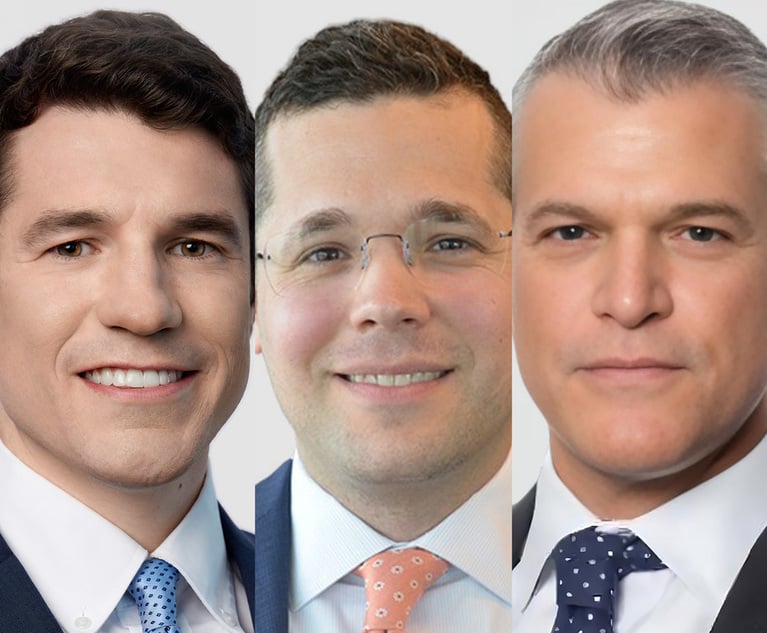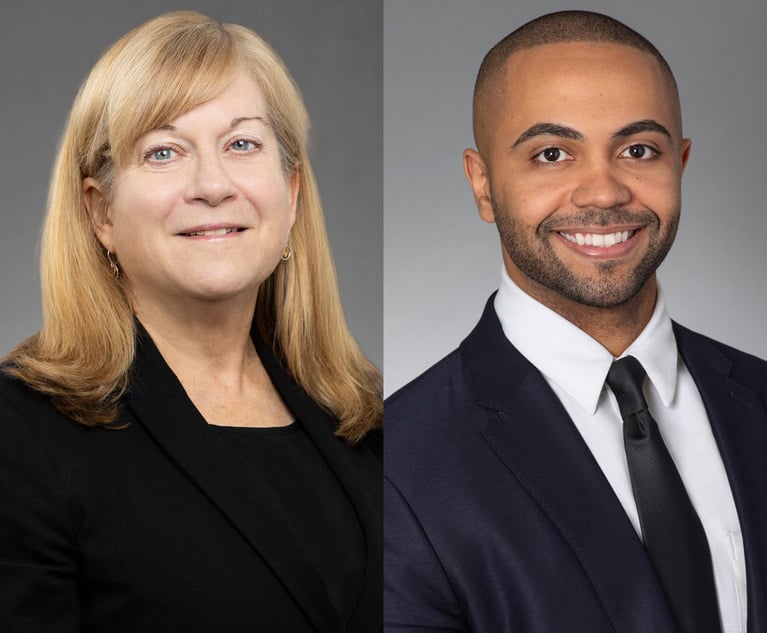Subprime Auto Lenders Folding—Is This a New Financial Indicator?
The recent Bloomberg headline “Smaller Subprime Auto Lenders Are Starting to Fold,” and the accompanying article may seem astounding in today's bustling economy.
May 11, 2018 at 10:00 AM
4 minute read

The recent Bloomberg headline “Smaller Subprime Auto Lenders Are Starting to Fold,” and the accompanying article may seem astounding in today's bustling economy. However, not far from the surface, significant issues and obstacles are facing this segment of the consumer financing and motor vehicle sales industries. According to the New York Fed Consumer Credit Panel/Equifax, nonbank lenders' subprime auto loans are going bad at the highest rate since 2010. According to the same report, as of the end of 2017, 6.3 million Americans were 90 days late on their auto loan payments, which was an increase of approximately 400,000 from a year earlier. According to the Federal Reserve Bank of New York, as of September 2017, there were approximately $280 billion of subprime auto loans outstanding. With a default rate of approximately 9 percent of those loans, the cumulative magnitude of consumers unable to pay their debts is substantial.
Most of the subprime loans are packaged into collateralization bundles and sold to high rate hungry investors, in a manner that is similar to the sale of subprime home mortgages leading up to the 2008 financial crisis. Given the fact that the subprime auto loan outstandings are substantially smaller than the 2008 home mortgage loan collateralization packages, one may ask if this statistic is only a glitch or an anomaly in a growing economy.
History demonstrates that the rate of defaults for subprime auto loans may be a much more significant indicator of future economic uncertainty than one may imagine. While there is no fixed category as to when a borrower becomes subprime, it is usually when FICO credit scores are below 600 to 641 on an 850-point scale. Since most of these consumers are dependent on their motor vehicles for transportation to and from work and since most of these borrowers do not have multiple vehicles at the same time, subprime auto borrowers will usually default or fail to pay all other types of consumer loans prior to creating a default on a motor vehicle loan, as the consequences of a repossession after default can be severe and consequential. When a car payment is missed, it usually means that no other debts are being paid as well.
The smaller subprime lenders that are folding are finding that their sources of investment are drying up because institutional and other investors are becoming wary of the high default rates, which places into jeopardy any cushion in the collateralization packages to accommodate a “normal” default rate. This will not only mean that high-risk consumers will have a more challenging time in finding available credit for motor vehicle purchases, but also the cost of such loans will increase. This will then decrease the ability of motor vehicle dealers to continue the current pace of vehicle sales.
Shortly after the Lehman Brothers collapse in 2008, the then largest Chevrolet dealer in the United States (the Bill Heard Chevrolet entities) sought Chapter 11 protection because a substantial portion of its customer base constituted subprime borrowers. And due to the unavailability and expense of subprime loans, these consumers were unable to purchase new and most late-model used vehicles. This was a forerunner and indicator of what was to develop shortly after that which led to the great recession of the last decade.
As the philosopher, George Santayana famously said, “Those who do not learn history are doomed to repeat it.” It appears that the so-called robust consumer economy may not be as flourishing as many would have us believe. Given the wild fluctuations of the major stock market indicators and the uncertainty of a possible trade war, we may be on the precipice of a bursting financial bubble, and to ignore the warning signs associated with the subprime auto defaults will be to the detriment of all who do so.
Charles M. Tatelbaum is chair of the creditors' rights practice group and a director of the Tripp Scott law firm in Fort Lauderdale.
This content has been archived. It is available through our partners, LexisNexis® and Bloomberg Law.
To view this content, please continue to their sites.
Not a Lexis Subscriber?
Subscribe Now
Not a Bloomberg Law Subscriber?
Subscribe Now
NOT FOR REPRINT
© 2025 ALM Global, LLC, All Rights Reserved. Request academic re-use from www.copyright.com. All other uses, submit a request to [email protected]. For more information visit Asset & Logo Licensing.
You Might Like
View All
Motions for Summary Judgment and Discovery: The 2021 Rule Changes Continue to Emerge
5 minute read

As a New Year Dawns, the Value of Florida’s Revised Mediation Laws Comes Into Greater Focus
4 minute read
Data Breaches, Increased Regulatory Risk and Florida’s New Digital Bill of Rights
7 minute readTrending Stories
Who Got The Work
Michael G. Bongiorno, Andrew Scott Dulberg and Elizabeth E. Driscoll from Wilmer Cutler Pickering Hale and Dorr have stepped in to represent Symbotic Inc., an A.I.-enabled technology platform that focuses on increasing supply chain efficiency, and other defendants in a pending shareholder derivative lawsuit. The case, filed Oct. 2 in Massachusetts District Court by the Brown Law Firm on behalf of Stephen Austen, accuses certain officers and directors of misleading investors in regard to Symbotic's potential for margin growth by failing to disclose that the company was not equipped to timely deploy its systems or manage expenses through project delays. The case, assigned to U.S. District Judge Nathaniel M. Gorton, is 1:24-cv-12522, Austen v. Cohen et al.
Who Got The Work
Edmund Polubinski and Marie Killmond of Davis Polk & Wardwell have entered appearances for data platform software development company MongoDB and other defendants in a pending shareholder derivative lawsuit. The action, filed Oct. 7 in New York Southern District Court by the Brown Law Firm, accuses the company's directors and/or officers of falsely expressing confidence in the company’s restructuring of its sales incentive plan and downplaying the severity of decreases in its upfront commitments. The case is 1:24-cv-07594, Roy v. Ittycheria et al.
Who Got The Work
Amy O. Bruchs and Kurt F. Ellison of Michael Best & Friedrich have entered appearances for Epic Systems Corp. in a pending employment discrimination lawsuit. The suit was filed Sept. 7 in Wisconsin Western District Court by Levine Eisberner LLC and Siri & Glimstad on behalf of a project manager who claims that he was wrongfully terminated after applying for a religious exemption to the defendant's COVID-19 vaccine mandate. The case, assigned to U.S. Magistrate Judge Anita Marie Boor, is 3:24-cv-00630, Secker, Nathan v. Epic Systems Corporation.
Who Got The Work
David X. Sullivan, Thomas J. Finn and Gregory A. Hall from McCarter & English have entered appearances for Sunrun Installation Services in a pending civil rights lawsuit. The complaint was filed Sept. 4 in Connecticut District Court by attorney Robert M. Berke on behalf of former employee George Edward Steins, who was arrested and charged with employing an unregistered home improvement salesperson. The complaint alleges that had Sunrun informed the Connecticut Department of Consumer Protection that the plaintiff's employment had ended in 2017 and that he no longer held Sunrun's home improvement contractor license, he would not have been hit with charges, which were dismissed in May 2024. The case, assigned to U.S. District Judge Jeffrey A. Meyer, is 3:24-cv-01423, Steins v. Sunrun, Inc. et al.
Who Got The Work
Greenberg Traurig shareholder Joshua L. Raskin has entered an appearance for boohoo.com UK Ltd. in a pending patent infringement lawsuit. The suit, filed Sept. 3 in Texas Eastern District Court by Rozier Hardt McDonough on behalf of Alto Dynamics, asserts five patents related to an online shopping platform. The case, assigned to U.S. District Judge Rodney Gilstrap, is 2:24-cv-00719, Alto Dynamics, LLC v. boohoo.com UK Limited.
Featured Firms
Law Offices of Gary Martin Hays & Associates, P.C.
(470) 294-1674
Law Offices of Mark E. Salomone
(857) 444-6468
Smith & Hassler
(713) 739-1250






